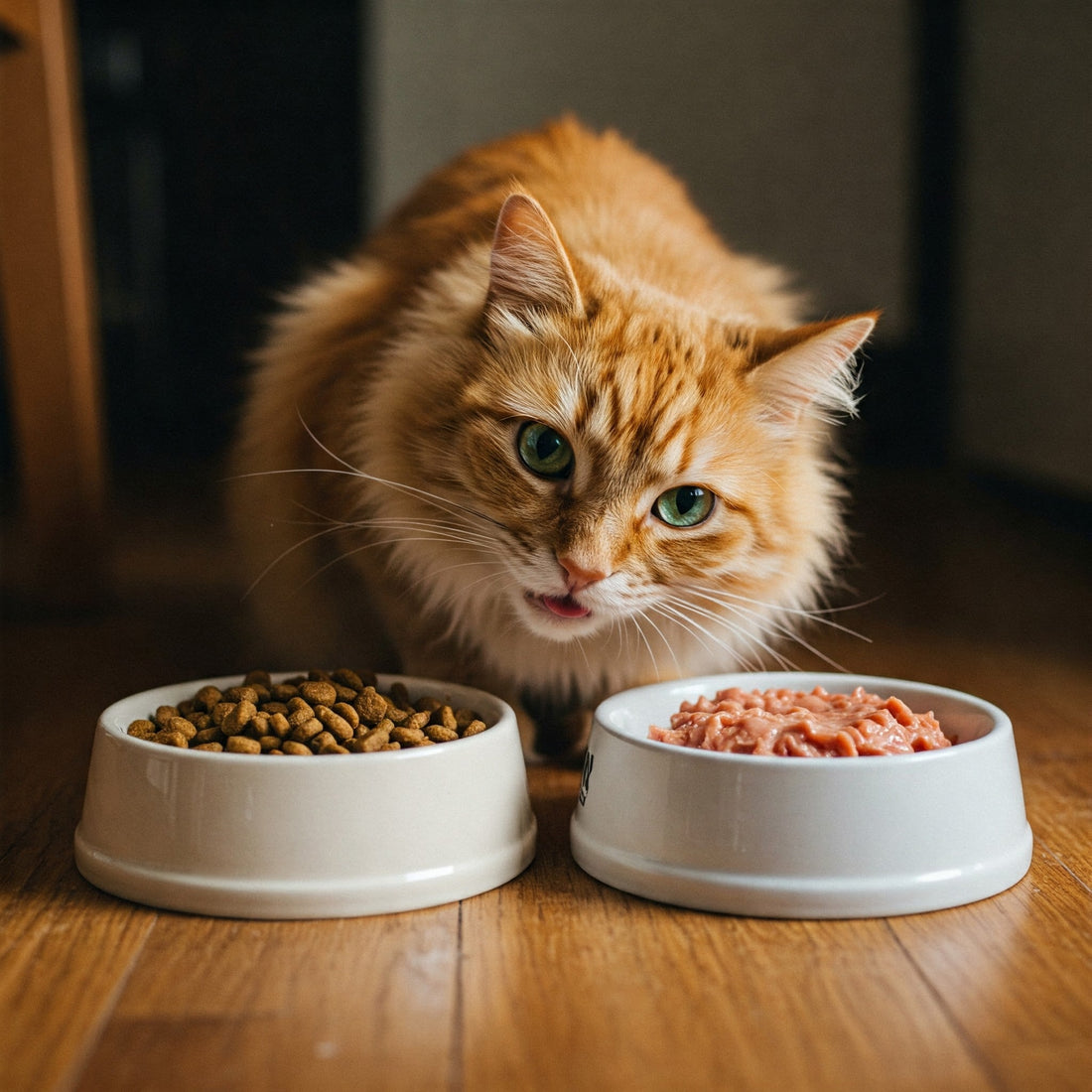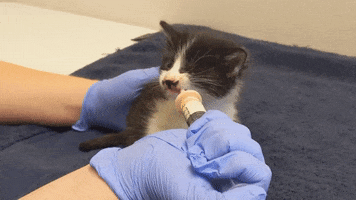
Transitioning Your Cat to a New Food: A Step-by-Step Guide
Share
Cats are creatures of habit with digestive systems finely tuned to their regular diet. Unlike humans who can often switch foods with minimal consequences, cats can experience significant digestive upset when their food changes too quickly. Vomiting, diarrhea and refusal to eat are common reactions to abrupt dietary changes. Beyond physical discomfort, sudden transitions can cause stress that manifests in behavioral issues like hiding or increased aggression. A gradual introduction helps your cat's digestive system adjust to new proteins, fats and carbohydrates while allowing them to become accustomed to different textures and flavors at their own pace. Whether switching to a higher-quality brand, addressing health concerns or simply introducing variety, taking time to transition properly ensures your cat remains healthy and comfortable throughout the process.

How Do I Safely Transition My Cat to a New Food Without Causing Digestive Upset?
There are several important reasons why you might need to change your cat's diet. As cats progress through different life stages, their nutritional requirements evolve significantly. Kittens need food formulated for growth and development while adult cats require maintenance nutrition and senior cats benefit from diets supporting aging bodies. Health concerns often necessitate dietary changes too - conditions like diabetes, kidney disease or food allergies may require therapeutic veterinary formulas. Weight management represents another common reason for transitioning food, whether helping an overweight cat slim down or assisting an underweight cat gain healthy pounds. Sometimes the change comes from practical considerations like discontinuation of a favorite brand or the simple desire to provide more dietary variety.
Before beginning any food transition, consulting your veterinarian is highly recommended. They can assess whether the new food meets your cat's specific nutritional needs and advise on any special considerations for health conditions. Your vet can also recommend appropriate portion sizes and help create a customized transition timeline based on your cat's age, weight and overall health status. This professional guidance becomes especially crucial when switching to prescription diets or addressing medical issues. Veterinarians can also identify potential nutrient deficiencies or excesses in the new food and suggest supplements if needed.
3-in-1 Cat Spoon, Lid & Can Opener
The most widely recommended method for transitioning cat food is the gradual mix-in approach spanning seven to ten days. This slow process allows your cat's digestive system to adapt while giving them time to accept the new taste and texture. Begin by mixing approximately 25% new food with 75% current food for the first few days. Observe your cat closely during this initial phase - look for normal eating habits, consistent energy levels and healthy litter box output. If no issues arise after two to three days, increase to a 50/50 blend for another few days. The next stage involves 75% new food mixed with 25% old food before finally transitioning completely to the new diet.
Some cats require an even slower transition than the standard week-long process. Senior cats, those with sensitive stomachs or cats with a history of food aversion may need two weeks or longer to fully adjust. Pay close attention to your cat's reactions at each stage - if you notice decreased appetite, vomiting or diarrhea, extend the current mixing ratio for several more days before attempting to increase the new food percentage. The transition should always proceed at your cat's pace rather than following a rigid schedule.

Cats can be notoriously particular about food textures and temperatures. When introducing wet food to a cat accustomed to dry kibble, try warming it slightly to enhance aroma or mixing in a small amount of warm water to create a gravy-like consistency. For cats transitioning from wet to dry food, moistening the kibble with water or low-sodium broth can make it more appealing. Some cats prefer their food at room temperature rather than straight from the refrigerator. Experimenting with different presentations can help overcome texture-related objections during the transition period.
Behavioral strategies can significantly improve acceptance of new food. Establishing consistent meal times rather than free-feeding allows you to monitor exactly how much your cat is eating. Remove uneaten food after 20-30 minutes to encourage eating when the food is freshest. Try placing the new food in your cat's usual feeding spot while maintaining their normal routine to minimize stress. Some cats respond well to having the new food offered separately at first, placed alongside their familiar meal so they can investigate it voluntarily. Positive reinforcement like gentle praise or petting during meals can create pleasant associations with the new food.
Cat Ear Food & Water Dispenser
Monitoring your cat's health throughout the transition remains critically important. Watch for sustained energy levels, normal grooming habits and consistent litter box patterns. Healthy stools should maintain their usual firmness and frequency - significant changes may indicate the need to slow the transition. Weight should remain stable unless intentional weight loss or gain is the goal. Any signs of prolonged digestive upset, lethargy or refusal to eat for more than 24 hours warrant immediate veterinary attention. Keeping a simple log of food amounts consumed and any reactions can help identify patterns and guide adjustment of the transition pace.
Special circumstances require modified transition approaches. For cats with food allergies, the transition must be extremely controlled to accurately identify problem ingredients. Multiple protein sources should never be introduced simultaneously in these cases. Kittens generally adapt more quickly than adult cats but still benefit from gradual transitions between growth-stage foods. Multi-cat households may require separate feeding stations to ensure each cat eats the appropriate food during transition periods. Cats recovering from illness often need extra patience and potentially different transition strategies tailored to their condition.
The long-term benefits of a successful food transition make the effort worthwhile. A properly executed switch to higher quality nutrition can result in improved coat condition, better digestion, increased energy levels and enhanced overall health. Cats receiving optimal nutrition often demonstrate fewer hairballs, healthier weight maintenance and improved immune function. The transition process itself can strengthen the bond between cat and owner through positive feeding interactions and attentive care.

Even after completing the transition, continue observing your cat's response to the new food for several weeks. Some effects like coat improvements or digestive changes may take time to become apparent. Be prepared to make minor adjustments to portion sizes as your cat's metabolism adapts to the new nutritional profile. Remember that occasional treats or supplements should complement rather than disrupt the balanced nutrition provided by the main diet.
Patience and flexibility remain the keys to successful food transitions. Every cat has unique preferences and tolerances that influence how quickly they adapt to change. Some embrace new foods enthusiastically while others require weeks of gentle encouragement. By respecting your cat's individual needs and proceeding at their comfort level, you can navigate dietary changes with minimal stress for both of you. The ultimate reward comes in seeing your cat thrive on a diet that supports their health and happiness for years to come.


